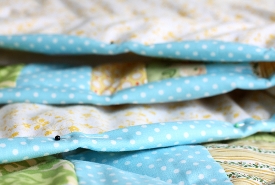Flat quilts can still get wavy borders
 We have all had quilts come our way – or maybe we even made them – where the borders were a bit more generous than we would like. These pre-existing waves can make an otherwise gorgeous quilt become mediocre. But what about the quilt that shows up where everything lays flat and perfect…yet when you see it hanging in the quilt show the borders are suddenly waving back? How does that happen?
We have all had quilts come our way – or maybe we even made them – where the borders were a bit more generous than we would like. These pre-existing waves can make an otherwise gorgeous quilt become mediocre. But what about the quilt that shows up where everything lays flat and perfect…yet when you see it hanging in the quilt show the borders are suddenly waving back? How does that happen?
The answer can be traced back to just a few possible culprits. The most common reason borders are wavy after the quilting has really nothing to do with the actual quilting.
Aren’t you relieved?
The waviness creeps in during the binding attachment. This is especially true if the border quilting design floats inside the border’s perimeter, rather than leaving the quilt’s outer edge as with pantograph quilting.
When the quilting design is confined to the border only, the stitches cause the border fabric to draw up, just like other areas of the quilt. However, the outer raw edgeof the border does NOT shrink in relation to the design inside the border. Instead, you’ll see soft ripples in the quilt top along the outer raw edge.
To prevent waves from appearing on an otherwise flat quilt, the binding fabric must rest on top of the raw edge while allowing those soft ripples to ease themselves under the binding. Unfortunately, quilters often pull this outer edge flat, trying to make those soft ripples disappear as they attach the binding. Instead, you are stretching out the very outer edge, resulting in waves when the binding is sewn down!
Another culprit to waves on an otherwise flat quilt is fabric tautness. The tighter the fabric appears on the rollers, the greater the chance of ripples when you are finished. Be sure the fabric is only tight enough to prevent pleats or puckers. Too tight, and the quilt is being pulled beyond its normal resting state.
One final troublemaker is inconsistent quilting density. Borders that have fewer quilting stitches than the body of the quilt will ripple much more than borders with comparable stitching amounts to the rest of the quilt. In addition, puffy batting makes this discrepancy more noticeable. Strive for balance between all areas of your quilt to get the flattest project possible.



